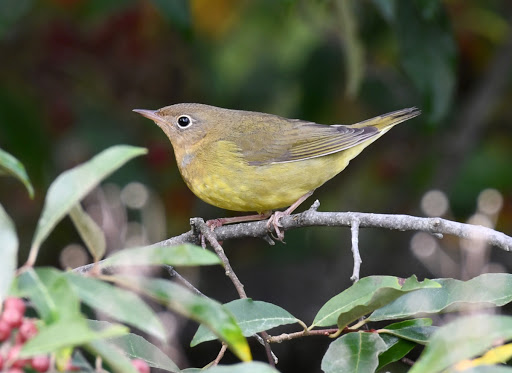Guest Post by Tim Spahr: Finding Connecticut Warblers in Fall Migration
In recent years, thanks to good old fashioned field work, Tim Spahr of Massachusetts has developed a knack for finding Connecticut Warblers in southern New England during autumn migration. He is kind enough to share his secrets with us here. Thank you, Tim!
-------------------------------------------------------------------------------------
Finding Connecticut Warblers in Fall Migration
by Tim Spahr
Connecticut Warblers are sought-after species due their shy and retiring nature, elusiveness, and overall rarity. Northeastern United States birders are fortunate to get a shot at these birds during the fall migration period, as they often stop in our area to refuel ahead of their long, overwater flight to South America. The sheer difficulty of locating one of these gems in migration can also make finding one a satisfying conclusion to any fall birding outing.
General information:
Connecticut Warblers breed from Western Quebec westward across the boreal regions of Canada (and the northern United States) into Manitoba and even Yukon. Their preferred breeding habitat is bogs and swamp edges, and some spruce and upland forest as well. Connecticut Warblers follow an odd racetrack-shaped migration route, with spring migration being through Florida and up the Ohio Valley before spreading out into Canada. In fall, the birds take the same northeastern route as Blackpoll Warblers, filling up on fat before a 3+-day overwater flight to South America.
Fall migration is late, with the bulk of the birds passing through the Northeastern States in the second half of September. While they can be located coastally, in locations such as Plum Island in Massachusetts, or Cape May in New Jersey, their preferred habitat is around 50km inland and surprisingly in overgrown fields, preferably dense with ragweed and with sumac edges. In Massachusetts, the birds love untended squash and pumpkin fields lined with staghorn sumac. They also will use swampy forest edges and red maple swamps less frequently.
Once the proper habitat is located, finding the birds is still a great challenge. The birds are extremely shy and wary, and often will simply run away on the ground, similar to rails. Often they will fly directly into thickets when flushed and vanish immediately. There are keys to identifying even these fast flying birds. Look for the direct flight, similar to a thrush, and the thrush-like proportions but with a contrastless greenish look in flight. They often frequently give their buzzy flight note—identical to Blackpoll and Yellow Warblers—and this will separate them from any other warbler with these colors. Once safe in thickets or field edges, they often call an odd ‘pwik!’ call note, not really similar to any other bird in this habitat. Birds can sometimes be coaxed into the edge with playback of call notes or mob tapes, but just as often the birds are located simply by flushing them randomly while working these field edges.
Confirming these birds can also be a challenge, as silent Connecticut Warblers can be mistaken for Common Yellowthroats, Mourning Warblers, or Nashville Warblers. Many overeager birders see Common Yellowthroats with eye rings and follow this pitfall to misidentification. Key ID points for Connecticut Warblers usually include an extensive dull brown or gray hood, coming further down into the chest than Mourning Warblers, extremely long undertail coverts; a full and complete white or off-white eye ring (never broken at the front of the eye) and lastly a grayish or buffy throat, never showing bright yellow. When in full view, the proportions of a Connecticut Warbler will appear strange, as often these birds are storing so much fat they are bulging like a shorebird ahead of long migration.
So this autumn, starting in mid-September, how about checking your local fallow pumpkin or squash field, or other field overgrown with ragweed, and see if you can find a Connecticut Warbler? You will be adding a good scientific data point about a tough-to-find Northeastern specialty.
-------------------------------------------------------------------------------------
 |
| Copyright Tim Spahr |
Finding Connecticut Warblers in Fall Migration
by Tim Spahr
Connecticut Warblers are sought-after species due their shy and retiring nature, elusiveness, and overall rarity. Northeastern United States birders are fortunate to get a shot at these birds during the fall migration period, as they often stop in our area to refuel ahead of their long, overwater flight to South America. The sheer difficulty of locating one of these gems in migration can also make finding one a satisfying conclusion to any fall birding outing.
 |
| Copyright Tim Spahr |
General information:
Connecticut Warblers breed from Western Quebec westward across the boreal regions of Canada (and the northern United States) into Manitoba and even Yukon. Their preferred breeding habitat is bogs and swamp edges, and some spruce and upland forest as well. Connecticut Warblers follow an odd racetrack-shaped migration route, with spring migration being through Florida and up the Ohio Valley before spreading out into Canada. In fall, the birds take the same northeastern route as Blackpoll Warblers, filling up on fat before a 3+-day overwater flight to South America.
Fall migration is late, with the bulk of the birds passing through the Northeastern States in the second half of September. While they can be located coastally, in locations such as Plum Island in Massachusetts, or Cape May in New Jersey, their preferred habitat is around 50km inland and surprisingly in overgrown fields, preferably dense with ragweed and with sumac edges. In Massachusetts, the birds love untended squash and pumpkin fields lined with staghorn sumac. They also will use swampy forest edges and red maple swamps less frequently.
Once the proper habitat is located, finding the birds is still a great challenge. The birds are extremely shy and wary, and often will simply run away on the ground, similar to rails. Often they will fly directly into thickets when flushed and vanish immediately. There are keys to identifying even these fast flying birds. Look for the direct flight, similar to a thrush, and the thrush-like proportions but with a contrastless greenish look in flight. They often frequently give their buzzy flight note—identical to Blackpoll and Yellow Warblers—and this will separate them from any other warbler with these colors. Once safe in thickets or field edges, they often call an odd ‘pwik!’ call note, not really similar to any other bird in this habitat. Birds can sometimes be coaxed into the edge with playback of call notes or mob tapes, but just as often the birds are located simply by flushing them randomly while working these field edges.
Confirming these birds can also be a challenge, as silent Connecticut Warblers can be mistaken for Common Yellowthroats, Mourning Warblers, or Nashville Warblers. Many overeager birders see Common Yellowthroats with eye rings and follow this pitfall to misidentification. Key ID points for Connecticut Warblers usually include an extensive dull brown or gray hood, coming further down into the chest than Mourning Warblers, extremely long undertail coverts; a full and complete white or off-white eye ring (never broken at the front of the eye) and lastly a grayish or buffy throat, never showing bright yellow. When in full view, the proportions of a Connecticut Warbler will appear strange, as often these birds are storing so much fat they are bulging like a shorebird ahead of long migration.
So this autumn, starting in mid-September, how about checking your local fallow pumpkin or squash field, or other field overgrown with ragweed, and see if you can find a Connecticut Warbler? You will be adding a good scientific data point about a tough-to-find Northeastern specialty.
 |
| Copyright Tim Spahr |
 |
| Copyright Tim Spahr |
 |
| Copyright Tim Spahr |
-------------------------------------------------------------------------------------
[Nick's note: I put Tim's tips to work last autumn and was able to find a few CONWs in exactly the habitat he described. Two of the birds were flushed from the fields themselves (one ragweed, one overgrown squash), and one responded to pishing the tangles at the base of staghorn sumac at the edge of a pumpkin field that was overgrown with ragweed. Thank you again, Tim, for the fantastic information, photos, and sound clip.]



Very interesting. Good info. Will try it this fall. Thanks Nick and Tim.
ReplyDeleteAndrew Block
Great post Nick! I remember the first time I came across a Connecticut Warbler. It was sheer dumb luck. I remember trying to identify it, not sure if it was a Nashville, Yellowthroat, or Mourning Warbler, but when I saw it walk on the ground like a thrush, and immediately realized that it was a Connecticut!
ReplyDeleteI have had luck with finding CONW in edges of mugwort near White Pine groves.I read that CONW like White Pine plantations in migration.This was in the Peterson Warbler Guide. These sightings have all been in New York on Long Island in Queens County.
ReplyDeleteEric, good to know! I have also heard jewelweed and goldenrod as target plants, but my yield has been pretty low in those habitats over the years here in CT.
DeleteWonderful post and very helpful.
ReplyDeleteWow. Thanks for sharing your knowledge and great images.
ReplyDelete